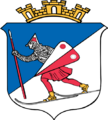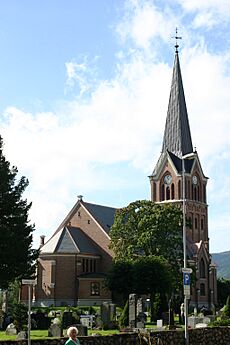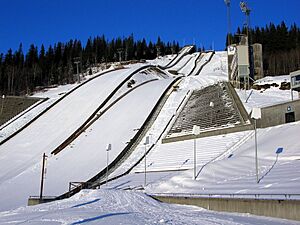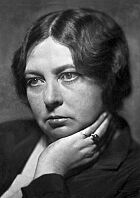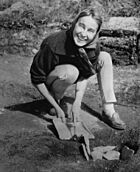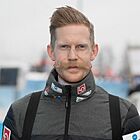Lillehammer facts for kids
Quick facts for kids
Lillehammer kommune
|
|||
|---|---|---|---|
|
Municipality
|
|||

View of the town of Lillehammer
|
|||
|
|||
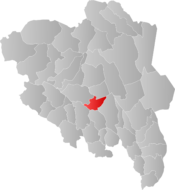
Lillehammer within Innlandet
|
|||
| Country | Norway | ||
| County | Innlandet | ||
| District | Gudbrandsdal | ||
| Established | 1 Jan 1838 | ||
| Administrative centre | Lillehammer | ||
| Area | |||
| • Total | 477.95 km2 (184.54 sq mi) | ||
| • Land | 450.72 km2 (174.02 sq mi) | ||
| • Water | 27.23 km2 (10.51 sq mi) 5.7% | ||
| Area rank | #211 in Norway | ||
| Population
(2023)
|
|||
| • Total | 28,560 | ||
| • Rank | #39 in Norway | ||
| • Density | 63.4/km2 (164/sq mi) | ||
| • Change (10 years) | 6.4% | ||
| Demonym(s) | Lillehamring | ||
| Time zone | UTC+01:00 (CET) | ||
| • Summer (DST) | UTC+02:00 (CEST) | ||
| ISO 3166 code | NO-3405 | ||
| Official language form | Bokmål | ||
| Created as | Formannskapsdistrikt in 1838 | ||
|
|
|||
Lillehammer (Norwegian pronunciation: [ˈlɪ̂lːəˌhɑmːər]) is a municipality in Innlandet county, Norway. It is located in the traditional district of Gudbrandsdal. The administrative centre of the municipality is the town of Lillehammer. Some of the more notable villages in the municipality include Fåberg, Hunderfossen, Jørstadmoen, Vingnes, and Vingrom.
The 478-square-kilometre (185 sq mi) municipality is the 211th largest by area out of the 356 municipalities in Norway. Lillehammer is the 39th most populous municipality in Norway with a population of 28,560. The municipality's population density is 63.4 inhabitants per square kilometre (164/sq mi) and its population has increased by 6.4% over the previous 10-year period.
The town of Lillehammer is the largest urban centre in the municipality. It lies in the central part of the municipality and it is surrounded by more rural areas. The town centre is a late nineteenth-century concentration of wooden houses, which enjoys a picturesque location overlooking the northern part of lake Mjøsa and the river Lågen, surrounded by mountains. Lillehammer hosted the 1994 Winter Olympics and 2016 Winter Youth Olympics.
Contents
General information
The municipality was established on 1 January 1838 (see formannskapsdistrikt law). On 1 January 1906, a small adjacent area of the neighboring municipality of Fåberg (population: 140) was annexed by Lillehammer to make room for more expansion as the town grew. During the 1960s, there were many municipal mergers across Norway due to the work of the Schei Committee. On 1 January 1964, the town of Lillehammer (population: 5,905) was merged with Fåberg Municipality (population: 13,381) to form a new, larger Lillehammer Municipality.
Name
The municipality (originally the parish) is named after the old Hamar farm (Old Norse: Hamarr) since the first Lillehammer Church was built there. The name is identical with the word hamarr which means "stone" or "rocky hill". To distinguish it from the nearby town of Hamar and Diocese of Hamar, it began to be called "little Hamar": Lilþlæ Hamar and Litlihamarr, and finally Lillehammer. It is also mentioned in the Old Norse sagas as Litlikaupangr ("Little Trading Place").
Coat of arms
The coat of arms was granted on 4 April 1898. The arms have are divided with a diagonal line. The field (background) above the line has a tincture of blue. Below the line, the field has a tincture of argent which means it is commonly colored white, but if it is made out of metal, then silver is used. The charge is a birkebeiner, carrying a spear and a shield, who is skiing down the mountainside under a blue sky. The design symbolizes the historical importance of when the Birkebeiners carried the future King Haakon from Lillehammer to Rena on skis. There is a mural crown above the escutcheon. The arms were designed by Andreas Bloch.
Churches
The Church of Norway has six parishes (sokn) within the municipality of Lillehammer. It is part of the Sør-Gudbrandsdal prosti (deanery) in the Diocese of Hamar.
| Parish (sokn) | Church name | Location of the church | Year built |
|---|---|---|---|
| Fåberg | Fåberg Church | Fåberg | 1727 |
| Lillehammer | Lillehammer Church | Lillehammer | 1882 |
| Nordre Ål | Nordre Ål Church | Lillehammer | 1994 |
| Nordseter Church | Nordseter | 1964 | |
| Saksumdal | Saksumdal Church | Lillehammer | 1875 |
| Søre Ål | Søre Ål Church | Lillehammer | 1964 |
| Vingrom | Vingrom Church | Vingrom | 1908 |
History
The village of Lillehammer is located at the northern end of Norway's largest lake, Mjøsa. There have likely been settlements here since the Iron Age and the market here was mentioned in Håkon Håkonson's saga in 1390. It is also mentioned as a site for Thing assembly in 1390. Tradition states that it was here in Lillehammer where the birkebeiners Torstein Skjevla and Skjervald Skrukka joined up with the King's son (and future King), Haakon, in 1205 before they traveled to Østerdalen (an event which is commemorated in March every year to this day). Since medieval times, the Lillehammer Church has been located here.
The village was granted market town rights on 7 August 1827. At that time, 50 people lived within the boundaries of the newly established town. This site was chosen because there were no other towns in all of Christians amt (county) and this site was located along the Gudbrandsdalslågen river and the whole Gudbrandsdal valley was a major transportation route from the capital to northern Norway. Within two years of the establishment of the town, the population had risen to 360 people. The merchant Ludvig Wiese has been counted as the founder of the town (a statue of him was erected in the town in connection with the town's 100th anniversary in 1927). The laying of the main railway line from the capital in Christiania to Eidsvoll was completed in 1852. This railway line was connected with steamships along the lake Mjøsa which travelled to Lillehammer and from there a newly laid road made connections further up into the Gudbrandsdalen valley. This transport system made the transit of timber and agricultural goods from all over the county to the capital possible, and it contributed to the growth of the town of Lillehammer.
In 1973, Mossad killed a Moroccan waiter, having mistaken him for Palestinian terrorist Ali Hassan Salameh, which became known as the Lillehammer affair.
Lillehammer is known as a typical venue for winter sporting events; it was host city of the 1994 Winter Olympics, and the 2016 Winter Youth Olympics, and was part of a joint bid with applicant host city Oslo to host events part of the 2022 Winter Olympics until Oslo withdrew its bid on 1 October 2014.
Lillehammer is home to the largest literature festival in the Nordic countries and, in 2017, was designated as a UNESCO City of Literature.
Education
A number of schools are located in Lillehammer, including the Hammartun Primary and Lower Secondary School, Søre Ål Primary School and Kringsjå Primary and Lower Secondary School. Lillehammer Upper Secondary School consists of two branches, North and South, both situated near the city center. The private high school Norwegian College of Elite Sports, NTG, also has a branch in Lillehammer. The Lillehammer campus of Inland Norway University of Applied Sciences is situated just north of the town itself.
Lillehammer is also the home of the Nansen Academy - the Norwegian Humanistic Academy. The Nansen Academy is an educational institution for adult students with varied political, religious, and cultural backgrounds. The Academy was founded on the core principles of humanism and aims at strengthening the knowledge of these principles.
The 14th World Scout Jamboree was held from 29 July to 7 August 1975 and was hosted by Norway at Lillehammer.
Geography
Lillehammer is situated in the lower part of the Gudbrandsdal valley, at the northern end of lake Mjøsa. It is located to the south of Øyer Municipality, to the southeast of Gausdal Municipality, northeast of Nordre Land Municipality, to the north of Gjøvik Municipality, and to the southeast of Ringsaker Municipality. The mountain Nevelfjell lies in the northeast part of the municipality.
Climate
Lillehammer has a humid continental climate (Köppen: Dfb) and used to have a subarctic climate (Köppen: Dfc), with the Scandinavian mountain chain to the west and north limiting oceanic influences. The record high of 34 °C (93 °F) was recorded in June 1970. The record low of −31 °C (−24 °F) was recorded in December 1978 and January 1979, and the same low was recorded in January 1987. There has been no overnight air frost in the month of August since 1978 with the record low for that month being −0.6 °C (30.9 °F). The coldest recorded temperature after 2000 is −26.2 °C (−15.2 °F) in January 2010. The average date for the last overnight freeze (low below 0 °C (32.0 °F)) in spring is May 10 and average date for first freeze in autumn is September 30 (1981-2010 average) giving an average frost-free season of 142 days. The current weather station Lillehammer-Sætherengen became operational in 1982; extremes are also from two earlier weather stations in Lillehammer.
| Climate data for Lillehammer 1991-2020 (240 m; extremes 1957 - 2018) | |||||||||||||
|---|---|---|---|---|---|---|---|---|---|---|---|---|---|
| Month | Jan | Feb | Mar | Apr | May | Jun | Jul | Aug | Sep | Oct | Nov | Dec | Year |
| Record high °C (°F) | 10.4 (50.7) |
12.5 (54.5) |
16.0 (60.8) |
23.4 (74.1) |
28.5 (83.3) |
34.0 (93.2) |
32.4 (90.3) |
33.0 (91.4) |
26.4 (79.5) |
19.5 (67.1) |
16.2 (61.2) |
11.3 (52.3) |
34.0 (93.2) |
| Mean daily maximum °C (°F) | −3.3 (26.1) |
−1.8 (28.8) |
3.7 (38.7) |
9.4 (48.9) |
15.4 (59.7) |
19.3 (66.7) |
21.7 (71.1) |
19.9 (67.8) |
14.9 (58.8) |
7.2 (45.0) |
1.2 (34.2) |
−2.8 (27.0) |
8.7 (47.7) |
| Daily mean °C (°F) | −6.1 (21.0) |
−5.4 (22.3) |
−1.2 (29.8) |
4 (39) |
9.4 (48.9) |
13.7 (56.7) |
16.1 (61.0) |
14.5 (58.1) |
10.1 (50.2) |
4.1 (39.4) |
−1.2 (29.8) |
−5.5 (22.1) |
4.4 (39.9) |
| Mean daily minimum °C (°F) | −8.4 (16.9) |
−8.1 (17.4) |
−4.6 (23.7) |
0 (32) |
4.5 (40.1) |
8.8 (47.8) |
11.4 (52.5) |
10.1 (50.2) |
6.4 (43.5) |
1.4 (34.5) |
−3.0 (26.6) |
−7.6 (18.3) |
0.9 (33.6) |
| Record low °C (°F) | −31.0 (−23.8) |
−29.5 (−21.1) |
−24.1 (−11.4) |
−14.0 (6.8) |
−5.4 (22.3) |
−2.2 (28.0) |
0.5 (32.9) |
−0.6 (30.9) |
−5.8 (21.6) |
−14.5 (5.9) |
−22.5 (−8.5) |
−31.0 (−23.8) |
−31.0 (−23.8) |
| Average precipitation mm (inches) | 52 (2.0) |
35 (1.4) |
35 (1.4) |
35 (1.4) |
64 (2.5) |
70 (2.8) |
80 (3.1) |
96 (3.8) |
65 (2.6) |
69 (2.7) |
69 (2.7) |
47 (1.9) |
717 (28.3) |
| Mean monthly sunshine hours | 28 | 68 | 126 | 168 | 212 | 242 | 237 | 195 | 136 | 83 | 44 | 18 | 1,557 |
Populated places
Lillehammer Municipality is subdivided into the following populated places (i.e.: neighborhoods, quarters, villages, localities, settlements, communities, hamlets, etc.):
- Søre Ål
- Nordre Ål
- Lillehammer Centre
- Nybu
- Vårsetergrenda
- Røyslimoen
- Vingnes
- Jørstadmoen
- Fåberg
- Rudsbygd
- Saksumdal
- Vingrom
- Nordseter
- Hovemoen
- Busmoen
Economy
The basis for the economy of the municipality is its position as the northernmost point of the lake Mjøsa and as the gateway for the Gudbrandsdal region, through which the historical highway from Oslo to Trondheim passes. The Mesna river has provided the basis for several small industries through the years, but Lillehammer is now all but industry-less. –
Media
Transport
One of the major Norwegian rail lines, the Dovre Line, runs from Hamar to the north through Lillehammer on its way up the Gudbrandsdal valley, to terminate in the city of Trondheim. The European route E6 highway also passes through Lillehammer.
Attractions
In addition to the Olympic site, Lillehammer offers a number of other tourist attractions:
- Maihaugen, centrally located in Lillehammer, is the largest open-air museum in Norway, with 185 buildings, mostly from Lillehammer and the valley of Gudbrandsdalen.
- Garmo Stave Church (built around 1150)
- The Norwegian Olympic Museum is the only museum in Northern Europe that shows the whole Olympic history from the ancient times and up to today, including all Summer- and Winter games. The museum also houses the Norwegian Sports Hall of Fame and a special section about the Lillehammer `94 Olympic Winter games. The Museum is located in the indoor museum at Maihaugen.
- Lillehammer Art Museum
- Hafjell (Ski resort 15 km (9 mi) from Lillehammer, host of slalom and super-G in the Olympic games 1994)
- Kvitfjell (Ski resort 55 km (34 mi) from Lillehammer, host of downhill in the Olympic games 1994)
- The PS Skibladner is the world's oldest paddle steamer in scheduled service, launched in 1856. Summer sailings around lake Mjøsa: Lillehammer, Moelv, Gjøvik, Hamar, and Eidsvoll.
- The ski jump at Lysgårdsbakkene.
- Sjusjøen is a skiing destination with forest and mountain terrain only 20 kilometres (12 miles) away (east) from the centre of Lillehammer in the municipality of Ringsaker.
- The rock carvings at Drotten, Fåberg, west of Gudbrandsdalslågen about 1.5 km (0.9 mi) above Brunlaug bridge.
- The sculpture Mothership with Standing Matter by Antony Gormley in a pavilion by Snøhetta architects close to Lillehammer Station.
Sport
Sports clubs
- Lillehammer Ishockeyklubb (The team competes in Norway's major hockey league, the GET-League.)
- Lillehammer Innabandy Klubb
- Lillehammer Orienteringsklubb
- Lillehammer Skiklubb
- Lillehammer Fotballklubb
- Lillehammer Frisbee
- Roterud Idrettslag
Notable people
Arts
- Kalle Løchen (1865–1893), a Norwegian painter and actor
- Sigrid Undset (1882–1949), a novelist, awarded the Nobel Prize for Literature in 1928; lived at her home "Bjerkebæk" in Lillehammer from 1919 to 1940 and again after WWII.
- Odd Grythe (1918–1995), a Norwegian radio and TV personality
- Kjell Lund (1927–2013), a Norwegian architect, songwriter and singer
- Sveinung Hovensjø (born 1950), a Norwegian jazz musician, plays bass and guitar
- Kristin Sevaldsen (born 1966), a jazz musician (saxophone), composer, and music producer
- Atle Antonsen (born 1969), a Norwegian comic and actor, was born in Lillehammer
- Ingrid Olava (born 1981), a Norwegian singer and musician, born and grew up in Lillehammer
Public service
- Lars Olsen Skrefsrud (1840–1910), a Lutheran missionary in India
- Johan Lunde (1866–1938), a theologian and bishop of the Diocese of Oslo
- Ulrik Frederik Lange (1808–1878), educator and mayor of Lillehammer 1840s & 50s
- Margit Haslund (1885–1963), a women's advocate and mayor of Lillehammer in 1940
- Thor Bjørklund (1889–1975), an inventor, invented the Ostehøvel, a popular cheese slicer
- Anne Stine Ingstad (1918–1997), an archaeologist, discovered Norse remains in Canada
- Kai Holst (1913–1945), a seaman, fur farmer and resistance fighter during WWII
- Nils Slaatto (1922–2001), a prominent and influential Norwegian architect
- Egil Tynæs (1941–2004), an anthroposophical physician, died in Afghanistan
- Bjørn Simensen (born 1947), a director, Norwegian National Opera 1984/1990 & 1997/2009
- Torkil Damhaug (born 1958), a Norwegian physician and crime fiction writer
Sport
- Ove Nielsen (born 1924), a Danish rower, competed at 1952 Summer Olympics lives locally
- Petter Belsvik (born 1967), a football coach and former player with 383 club caps
- Jon Inge Høiland (born 1977), a former footballer with 396 club caps and 25 for Norway
- Anita Rapp (born 1977), a footballer and team gold medallist at the 2000 Summer Olympics
- Grete Eliassen (born 1986), an American-Norwegian freestyle skier
- Edvald Boasson Hagen (born 1987), a Norwegian professional road racing cyclist
- Robert Johansson (born 1990), a ski jumper with two bronze and a team gold medal at the 2018 Winter Olympics
- Robert Lee (born 2001), a ski jumper
Other
- Anders Uchermann-Sandvig (1898-1966), newspaper editor
Twin towns – sister cities
Lillehammer has sister city agreements with the following places:
Friendly cities
Lillehammer has also friendly relations with:
 Düsseldorf, Germany
Düsseldorf, Germany Minakami, Japan
Minakami, Japan Radviliškis, Lithuania
Radviliškis, Lithuania Sarajevo, Bosnia and Herzegovina
Sarajevo, Bosnia and Herzegovina
See also
 In Spanish: Lillehammer para niños
In Spanish: Lillehammer para niños


